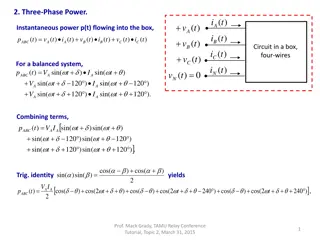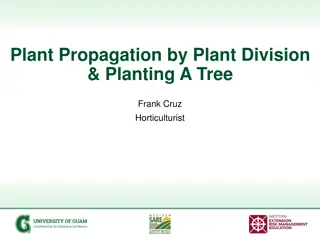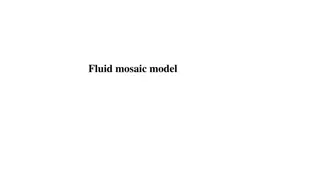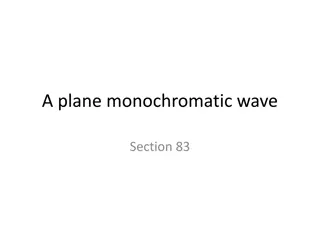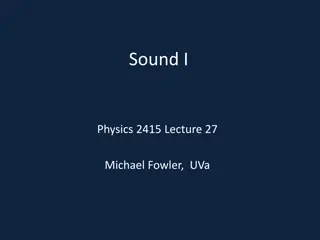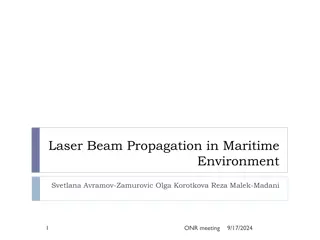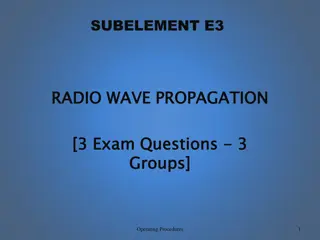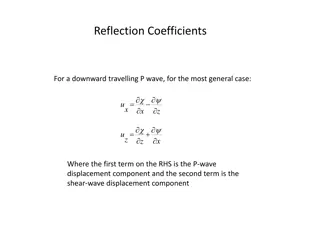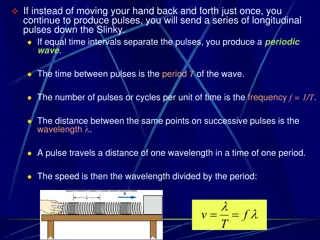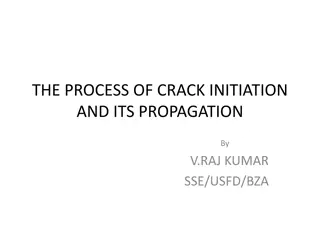Model for Wave Propagation in Poroelastic Medium Saturated by Three-Phase Fluid
We introduce a model describing wave propagation in a porous solid saturated by a three-phase fluid (oil, water, and gas). The model considers kinetic and dissipative energy density functions, laminar flow obeying Darcy's law, and capillary pressure functions. Elastic constants are determined using a generalized approach, resulting in the identification of compressional and shear waves. Numerical examples illustrate phase velocities and attenuation coefficients for a specific sandstone sample.
Download Presentation

Please find below an Image/Link to download the presentation.
The content on the website is provided AS IS for your information and personal use only. It may not be sold, licensed, or shared on other websites without obtaining consent from the author. Download presentation by click this link. If you encounter any issues during the download, it is possible that the publisher has removed the file from their server.
E N D
Presentation Transcript
A Biot model describing wave propagation in a porous solid saturated by a three-phase fluid Juan E. Santos1,2 and Gabriela B. Savioli1 1 - Instituto del Gas y del Petr leo, Facultad de Ingenier a, Universidad de Buenos Aires 2 - Department of Mathematics, Purdue University Universidad Nacional de La Plata, CONICET SUMMARY We present a model for the propagation of waves in a poroelastic medium saturated by a three-phase viscous, compressible fluid: oil, water and gas. The kinetic and dissipative energy density functions in the equations of motions are determined in terms of the mass densities of the solid and fluid phases. It is assumed that the flow is laminar, obeys Darcy s law for the three phases and is described in terms of the absolute permeability and three- phase relative permeability functions. The pressure differences between the oil and water phases and the oil and gas phases are included in the model using two capillary pressure functions. The elastic constants in the stress-strain relations are determined employing gedanken experiments that generalize those of Biot s theory for single-phase fluids. The presence of capillary forces imply the existence of four compressional waves, one fast and three slow, denoted Type I, II, III and IV waves, and one shear wave. Numerical examples show the phase velocities and attenuation coefficients of all waves for a sample of Nivelsteiner sandstone saturated by oil, gas and water. THE MODEL So, Sw, Sg: oil, water and gas saturations, So+ Sw+ Sg= 1 us ~ , u solid and -fluid displacements averaged over the bulk material, = o, w, g ( u u = ( ) ) ~ u~ iju s s = u : strain tensor, , = + : total stress of the bulk material ij ij ij = + : stress tensor in the solid ij ij ij = + p p p p : reference pressure : -fluid pressure, Capillary pressures: ( ) S ( ) S = = Pc p p , Pc p p go g g o ow o o w
Generalized forces ?? ??+ ???+ ??? ? ?? ???+ ??? ? ??, ?? ??+ ??? ? ??+ ??? ? ??? ? ?? ??? ? ??, ?? ??+ ???+ ??? ??+ ??? ? ?? ???+ ??? ??+ ??? ? ?? where ?? ?= ? ? ???? ???= ???? ?? ???? ??, ,??? ?= ? ? ???? ??, ???= ???? ?? ???? ??, ??? ??= ???? ?? ???? ?? ??? ( ) = se Stress-strain relations : ???= 2????+ ??? ???? ?1?? ?2?? ?3??, ii ??= ?1??+ ?1?? ?4?? ?5??, ??= ?2??+ ?4?? ?2?? ?6??, ??= ?3??+ ?5?? ?6?? ?3??, The elastic constants can be determined employing a set of gedanken experiments, generalizing those of Biot for single-phase fluids. Equation of motion : ?)?+ ?(? ? ?)? ?,? ? ?,? ? ?,? ? ?,? ? ?,? ? ?,? ? ?(? ? ? ,? ?? ??? ,? ?? ??? ,? ?? ??? = ? ??? ,? = 1,2,3 ??? : mass coupling 12X12 symmetric positive definite matrix, defined in terms of the mass coefficients of the individual phases ? ? : viscous coupling 12X12 symmetric non-negative matrix, defined in terms of the viscosity of the individual fluid phases, the absolute permeability and the three phase relative permeabilities. A plane wave analysis shows the existence of four compressional waves, denoted by Type I, II, III and IV, and one S or shear wave
NUMERICAL EXAMPLES The phase velocities and attenuation coefficients as function of frequency are computed for a sample of Nivelsteiner Sandstone with properties: = 0.33 ; k= 5 D; s = 2.65 gr/cm3, Ks = 36 GPa, Km= 6.21 GPa; N= 4.55 GPa p We choose two reference water pressures: = 20 and 30 MPa w GAS FLUID PROPERTIES OIL WATER =30 MPa w p =20 MPa w p ( gr/cm3) (Poise) K (GPa) 0.7 0.1 0.57 1 0.151545384 0.000128131716 0.000138663132 229138783.0 0.185844062 0.01 2.25 408195703.0 Capillary pressure functions : ( 1 ( 1 ) ) ( ) S ( ) S ( ( ) ) ( ( ) ) 2 2 = + 2 1 1 , 1 Pc A S S S S S S S S S S ow o ow o rw ro o ro rw ro o rw rg 2 2 = + 2 1 1 , 1 Pc A S S S S S S S S S S go g og g ro rg g rg ro rg g ro rw Relative permeability functions: ( ) S k r 2 S 1 S = , 1 , , , r S S S S p q p q r rp rq S r PURELY ELASTIC CASE (zero viscosities) Type I P and S wave phase velocities as function of gas saturation at Sw= 0.25 and pw= 20 and 30 MPa Type II, III and IV P-wave phase velocities as function of gas saturation at Sw= 0.25 and pw = 20 and 30 MPa Type II and III P-wave phase velocities decrease as Sgincreases, with higher values for increasing values of pw. Phase velocities of Type IV waves are almost independent of Sg, with their values increasing as pwincreases. Type I P-wave phase velocities show the characteristic decreasing behavior as gas saturation Sgincreases until a threshold value at which velocities start to increase. S-wave phase velocities are increasing functions of Sg. Notice that as pwincreases, velocities of Type I waves increase while S- waves velocities decrease.
THE GENERAL DISSIPATIVE CASE Type I P and S wave phase velocities as function of frequency at Sw= 0.25, Sg=0.1 and pw = 20, 30 MPa Type II, III and IV P-wave phase velocities as function of frequency at Sw= 0.25, Sg=0.1 and pw = 20, 30 MPa Phase velocities for Type I and S-waves show no dispersion for frequencies below 1 kHz and very little above. As pwincreases, velocities of Type I waves increase while S-waves velocities slightly decrease. Phase velocities of Type II, III and IV waves are almost zero at low frequencies, behaving as diffusion-type waves. At high frequencies they stabilize, with higher values for increasing values of pw. Type I P and S wave attenuations (dB) as function of frequency at Sw= 0.25, Sg=0.1 and pw = 20, 30 MPa Type II, III and IV P-wave attenuations (dB) as function of frequency at Sw= 0.25, Sg=0.1 and pw = 20, 30 MPa Type I and S-wave attenuations are almost zero at low frequencies and very small at high frequencies, with attenuation peaks located at the same frequency for both waves. Attenuation for Type I waves is higher for lower pw, while for S- waves is independent of pw. Attenuation for Type II, III and IV waves is very high at low frequencies and decay at high frequencies, where they become truly propagating waves. Besides, attenuation is almost independent of pw. CONCLUSIONS We presented a model to describe wave propagation in a poroelastic solid saturated by a three-phase fluid. The analysis shows that the Type I, Type II and S-waves behave as in the single-phase Biot theory (Biot, M.A., 1956). The Type III and IV compressional waves are diffusion-type slow waves at low frequencies, becoming truly propagating waves at high frequencies. Their existence is due to the presence of capillary forces between the three immiscible fluids saturating the pore space. Further analysis of the behavior of all the waves predicted by this model is the subject of current research.






